Unintentional drowning mortality, by age and body of water: an analysis of 60 countries
- PMID: 24944343
- PMCID: PMC4501178
- DOI: 10.1136/injuryprev-2013-041110
Unintentional drowning mortality, by age and body of water: an analysis of 60 countries
Abstract
Background: To examine unintentional drowning mortality by age and body of water across 60 countries, to provide a starting point for further in-depth investigations within individual countries.
Methods: The latest available three years of mortality data for each country were extracted from WHO Health Statistics and Information Services (updated at 13 November 2013). We calculated mortality rate of unintentional drowning by age group for each country. For countries using International Classification of Disease 10 (ICD-10) detailed 3 or 4 Character List, we further examined the body of water involved.
Results: A huge variation in age-standardised mortality rate (deaths per 100 000 population) was noted, from 0.12 in Turkey to 9.19 in Guyana. Of the ten countries with the highest age-standardised mortality rate, six (Belarus, Lithuania, Latvia, Russia, Ukraine and Moldova) were in Eastern Europe and two (Kazakhstan and Kyrgyzstan) were in Central Asia. Some countries (Japan, Finland and Greece) had a relatively low rank in mortality rate among children aged 0-4 years, but had a high rank in mortality rate among older adults. On the contrary, South Africa and Colombia had a relatively high rank among children aged 0-4 years, but had a relatively low rank in mortality rate among older adults. With regard to body of water involved, the proportion involving a bathtub was extremely high in Japan (65%) followed by Canada (11%) and the USA (11%). Of the 13 634 drowning deaths involving bathtubs in Japan between 2009 and 2011, 12 038 (88%) were older adults aged 65 years or above. The percentage involving a swimming pool was high in the USA (18%), Australia (13%), and New Zealand (7%). The proportion involving natural water was high in Finland (93%), Panama (87%), and Lithuania (85%).
Conclusions: After considering the completeness of reporting and quality of classifying drowning deaths across countries, we conclude that drowning is a high-priority public health problem in Eastern Europe, Central Asia, Japan (older adults involving bathtubs), and the USA (involving swimming pools).
Published by the BMJ Publishing Group Limited. For permission to use (where not already granted under a licence) please go to http://group.bmj.com/group/rights-licensing/permissions.
Figures
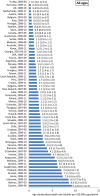

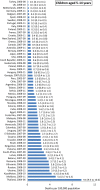
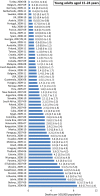
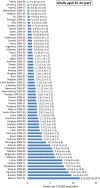

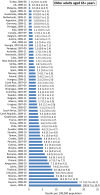
References
-
- Barss P, Smith GS, Baker SP, et al. Unintentional injuries: drownings, falls, and burns. In: Barss P, Smith GS, Baker SP, Mohan D. eds Injury prevention: an international perspective. New York: Oxford University Press, 1998:153.
-
- Brenner RA, Taneja G. Injury prevention: drowning. Rivara F, tpic ed In: Tremblay RE, Boivin M, Peters RdeV. eds Encyclopedia on early childhood develpment [online]. Montreal, Quebec: Centre of Excellence for Early Childhood Develpment and Strategic Knowledge Cluster on Early Child Deveopment, 2010:1–6.
-
- Steensberg J. Epidemiology of accidental drowning in Denmark 1989–1993. Acc Anal Prev 1998;30:755–62. - PubMed
-
- Ahmed MK, Rahman M, van Ginneken J. Epidemiology of child deaths due to drowning in Matlab, Bangladesh. Int J Epidemiol 1999;28:306–11. - PubMed
Publication types
MeSH terms
LinkOut - more resources
Full Text Sources
Other Literature Sources
Medical
